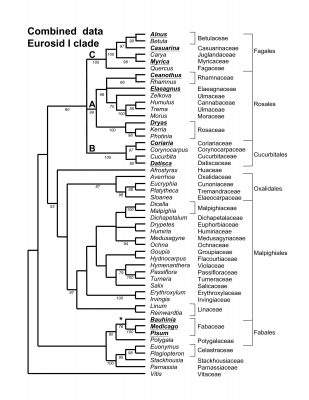The "Nitrogen-fixing" Clade
It was once thought that actinorhizal plant families were only distantly related. Molecular phylogenies for angiosperms based on sequences from the chloroplast gene for the large subunit of ribulose-1,5-bisphosphate carboxylase/oxygenase, (rbcL) (Chase et al., 1993) revealed that actinorhizal angiosperms fell in the “Rosid I” clade, later termed “Eurosids I” (Angiosperm Phylogeny Group = APG (1998)). In addition, the clade contained the two plant families with members that form symbiotic relationships with rhizobia, the Fabaceae (containing the legumes) and Cannabaceae (housing Parasponia). This clustering led to the suggestion that the "predisposition" to form symbiotic nitrogen fixing root nodules evolved once.
Additional analyses of the evolution of the actinorhizal symbioses were done (e.g. Jeong et al., 1999; Roy and Bousquet, 1996; Swensen and Mullin, 1997; Swensen, 1996) using a variety of molecular markers, including the 18S ribosomal RNA gene of the nuclear ribosomal DNA repeat and the chloroplast-encoded ATP synthase beta subunit (atpB) gene (Soltis and Soltis, 2000). A maximum parsimony tree using the combined data from the three loci places actinorhizal taxa into three subclades, the Fagales, Rosales, and Cucurbitales (above). These subclades contain, respectively, the actinorhizal members of the Betulaceae, Casuarinaceae, and Myricaceae; the Rosaceae, Rhamnaceae and Elaeagnaceae; and the Datiscaceae and Coriariaceae.
The majority of plants in the three orders that include actinorhizal taxa do not form the symbiosis, a situation also found in several of the actinorhizal families. All members are nodulated in the Coriariaceae, Elaeagnaceae, Datiscaceae and Casuarinaceae whereas only a portion of the genera are nodulated in the Betulaceae, Myricaceae, Rhamnaceae and the Rosaceae. In at least one case (Dryas), nodulation apparently does not extend to all members of a single genus (Kohls et al., 1994). These observations have led to the conclusion that, while the potential to form the nitrogen-fixing symbiosis may have evolved once, the realization of that potential has occurred and/or been lost multiple times (Benson and Clawson, 2000; Swensen, 1996).
For a discussion of the fossil record as it relates to the present day distribution of actinorhizal plants and Frankia, please refer to sections on each plant family.
